Accelerate > Publications
Search this online library featuring the latest FAO publications, issue papers and briefs which offer up-to-date knowledge and innovative insights for SDG acceleration.
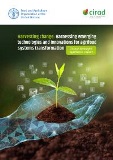
Harvesting change: Harnessing emerging technologies and innovations for agrifood system transformation - Global foresight synthesis report
2023
This study assesses a selection of technologies and innovations, which potentially could be of paramount importance in addressing agrifood challenges until 2050, as well as the most important trends and drivers that will influence the emergence of agrifood technologies and innovations and their triggers of change, including some regional aspects.
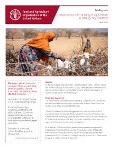
Importance of investing in agriculture in emergency contexts
2023
With 222 million people experiencing high acute food insecurity across 53 countries, and an alarming food security outlook for 2023, investing in agriculture in emergency contexts has never been so critical. Agriculture assistance is life-saving. It is significantly less expensive to help rural families produce food, than to provide them food.

A rapid review of effective financing for policy, implementation and partnerships addressing drought risks
2022
The report presents an overview of current knowledge and thinking concerning the effectiveness of three distinct layers of financing that set out to address drought risks in different ways. For each of these, results are conceptualized and measured in different ways for disaster risk reduction, adaptation to climate change, and transformative green finance.

South-South in Action - South-South and triangular cooperation in agricultural development: FAO's experiences
2022
This publication outlines key features of South-South and Triangular Cooperation (SSTC) and how FAO has applied SSTC to the delivery of its mission. The case studies presented provide a window on how SSTC has contributed to alleviating hunger and malnutrition in countries across the global South and has helped build resilience in the face of climate change and other development challenges.
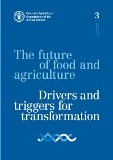
The future of food and agriculture – Drivers and triggers for transformation
2022
This report aims at inspiring strategic thinking and actions to transform agrifood systems towards a sustainable, resilient and inclusive future, by building on both previous reports in the same series as well as on a comprehensive corporate strategic foresight exercise that also nurtured FAO Strategic Framework 2022–31. It analyses major drivers of agrifood systems and explores how their trends could determine alternative futures of agrifood, socioeconomic and environmental systems.
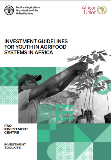
Investment guidelines for youth in agrifood systems in Africa
2022
The Investment guidelines for youth in agrifood systems in Africa, developed jointly by FAO and the African Union Commission (AUC) through a multi-stakeholder and participatory process, highlight the importance of youth as change agents and key stakeholders contributing to sustainable agrifood systems. The guidelines aim to accelerate investments in and by youth in agrifood systems by providing practical guidance - including tools and examples ...

A multi-billion-dollar opportunity – Repurposing agricultural support to transform food systems
2021
Public support mechanisms for agriculture in many cases hinder the transformation towards healthier, more sustainable, equitable, and efficient food systems, thus actively steering us away from meeting the Sustainable Development Goals and targets of the Paris Agreement. This report sets out the compelling case for repurposing harmful agricultural producer support to reverse this situation, by optimizing the use of scarce public resources...

Nature-based solutions in agriculture: Project design for securing investment
2021
Today, the global food system drives a ten trillion-dollar economy that connects 7.5 billion consumers and a diverse array of more than 1 billion food producers (farmers, ranchers, pastoralists, and fish harvesters). Approximately one-half of the world’s habitable lands are used for agriculture (Ritchie, 2019). Not surprisingly, the food production system has a massive impact on our planet. As we look to the future, global food demand is set to increase 50%,...
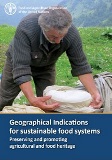
Geographical Indications for sustainable food systems - Preserving and promoting agricultural and food heritage
2019
A geographical indication (GI) is a label that applies to products with specific quality, reputation or other characteristics resulting from their geographical origin. These specific characteristics can be the result of natural or human factors. GIs are protected by intellectual property rights (IPR) according to the World Trade Organization agreement on Trade-Related Aspects of Intellectual Property Rights (TRIPS) and the Geneva Act.
Browse by SDG
- SDG1: No Poverty
- SDG2: Zero Hunger
- SDG3: Good Health & Well-being
- SDG4: Quality Education
- SDG5: Gender Equality
- SDG6: Clean Water & Sanitation
- SDG7: Affordable and Clean Energy
- SDG8: Decent Work and Economic Growth
- SDG9: Industry, Innovation and Infrastructure
- SDG10: Reduced Inequalities
- SDG11: Sustainable Cities and Communities
- SDG12: Responsible Consumption and Production
- SDG13: Climate Action
- SDG14: Life Below Water
- SDG15: Life on Land
- SDG16: Peace, Justice and Strong Institutions
- SDG17: Partnerships for the Goals
Browse by Better
Browse by Priority Area
- Innovation for Sustainable Agriculture Production
- Blue Transformation
- One Health
- Small-Scale Producers' Equitable Access to Resources
- Digital Agriculture
- Healthy Diets for All
- Nutrition for the Most Vulnerable
- Safe Food for Everyone
- Reducing Food Loss and Waste
- Transparent Markets and Trade
- Climate Change Mitigating and Adapted Agrifood Systems
- Bioeconomy for Sustainable Food and Agriculture
- Biodiversity and Ecosystem Services for Food and Agriculture
- Achieving Sustainable Urban Food Systems
- Gender Equality and Rural Women's Empowerment
- Inclusive Rural Transformation
- Agriculture and Food Emergencies
- Resilient Agrifood Systems
- Hand-in-Hand Initiative
- Scaling up Investment
